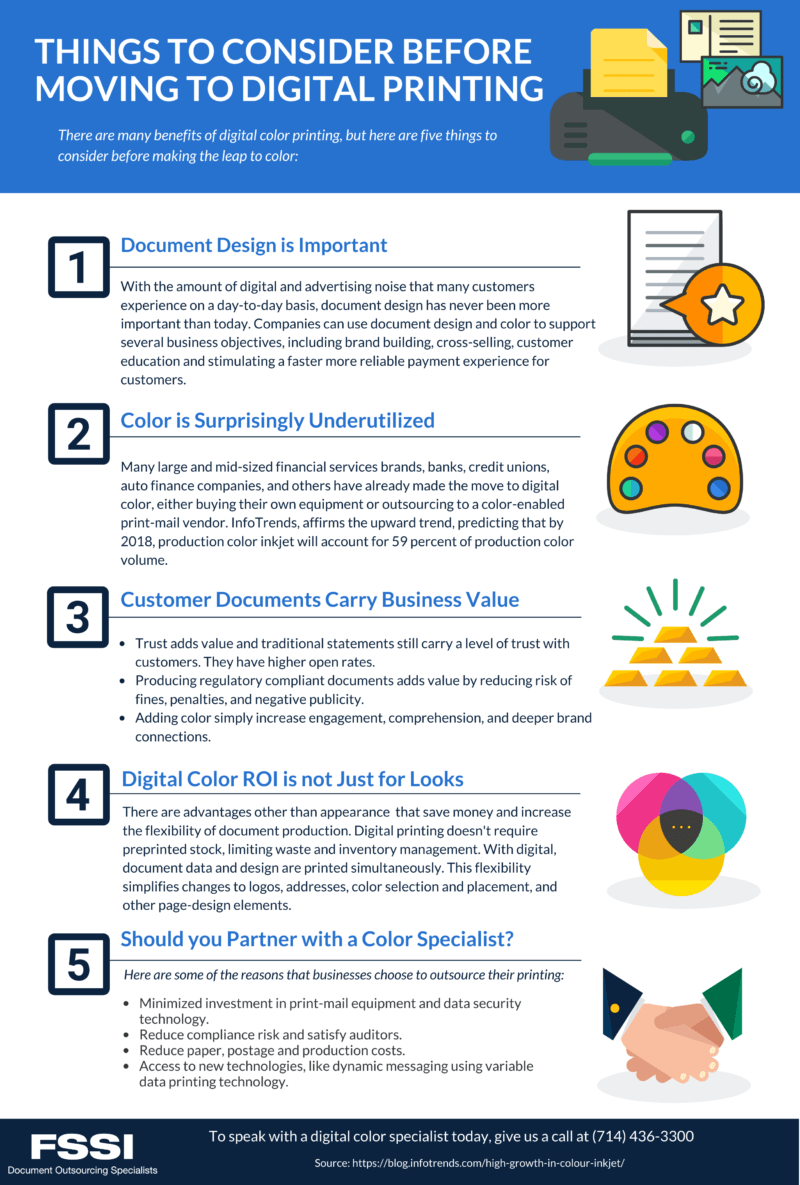The Ultimate Guide To Digital Printing
Table of ContentsThe Ultimate Guide To Digital PrintingDigital Printing Fundamentals ExplainedSome Known Factual Statements About Digital Printing An Unbiased View of Digital PrintingDigital Printing for DummiesWhat Does Digital Printing Mean?
Variable information printing, such as straight mail with customized codes and addresses, is preferably matched for electronic printing. Digital quick printing only needs 4 actions of layout, testimonial, printing and binding to obtain whatever done. Digital quick printing has an unmatched benefit: print on need.According to PMMI, electronic printing enables brands and makers to respond rapidly to consumer needs while boosting the supply chain, lowering warehousing price and waste, and enjoying faster time to market. That all sounds wonderful, but exactly how does this innovation do all that? The significant differentiator of these technologies is that there are no set-up charges and no plates with electronic printing.
Indicators on Digital Printing You Should Know
According to Wikipedia, the best difference between digital printing and typical methods such as lithography, flexography, gravure, or letterpress - Digital Printing is that there is no requirement to replace printing plates in electronic printing, whereas in these analog printing techniques the plates are continuously replaced. This results in quicker turnaround time and decreases cost when utilizing digital printing.
Digital printing is highly adaptable, so it's easy to make modifications to the package design promptly. It all goes back to the plates.
With traditional printing techniques, short-run printing is just not possible. Due to the fact that a great layout can make or damage your item, electronic printing consistently produces top quality, clear and vibrant graphics each time.
Digital printing is the procedure of printing digital-based images straight onto a variety of media substrates. There is no demand for a printing plate, unlike with balanced out printing. Digital documents such as PDFs or desktop computer posting data can be sent straight to the digital printing press to print theoretically, photo paper, canvas, fabric, synthetics, cardstock and various other substrates.
6 Easy Facts About Digital Printing Shown
According to PMMI, electronic printing permits brand names and makers to respond rapidly to client demands while boosting the supply chain, reducing warehousing price and waste, and taking pleasure in faster time to market. That all noises fantastic, yet how does this innovation do all that? The major differentiator of these technologies is that there are no set-up fees and no plates with digital printing.
This results in quicker turn-around time and decreases price when using electronic printing.

The Ultimate Guide To Digital Printing
Extra stock can indicate even more waste later on. With conventional printing techniques, short-run printing is just not possible. Since a fantastic design can make or break your product, digital printing continually produces high-grade, clear and vibrant graphics each time. Digital printing on flexible bags includes the intense, dynamic, and accurate graphics that practically bid customers to connect and touch them.

According to PMMI, electronic printing permits brand names and producers to react promptly to customer demands while improving the supply chain, minimizing warehousing cost and waste, and delighting in faster time to market. More about the author That all noises terrific, but exactly how does this innovation do all that? The significant differentiator of these modern technologies is that there are no set up costs and no plates with digital printing.
Digital Printing Things To Know Before You Buy
According to Wikipedia, the best difference in between digital printing and traditional techniques such as lithography, flexography, gravure, or letterpress is that there is no need to change printing plates in digital printing, whereas in these analog printing approaches the plates are continuously changed. This leads to quicker turnaround time and lowers cost when using electronic printing.
Digital printing is extremely flexible, so it's simple to make changes to the package layout rapidly. It all goes back to the plates.

The Best Strategy To Use For Digital Printing
Digital printing is the process of printing digital-based pictures straight onto a range of media substratums. There is Visit Website no demand for a printing plate, unlike with balanced out printing. Digital documents such as PDFs or desktop posting documents can be sent directly to the digital printing machine to print on paper, photo paper, canvas, material, synthetics, cardstock and other substrates.